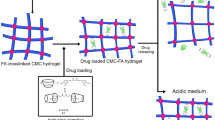Abstract
Biodegradable hydrogels based on glycidyl methacrylate dextran (GMD) and dimethacrylate poly(ethylene glycol) (DMP) were proposed for colon-specific drug delivery. GMD was synthesized by coupling of glycidyl methacrylate with dextran in the presence of 4-(N,N-dimethyl-amino)pyridine (DMAP) using dimethylsulfoxide as a solvent. Methacrylate-terminated poly (ethylene glycol) (PEG) macromer was prepared by the reaction of PEG with methacryloyl chloride. GMD/DMP hydrogels were prepared by radical polymerization of phosphate buffer solution (0.1M, pH 7.4) of GMD and DMP, using ammonium peroxydisulfate (APS) and UV as initating system. The synthetic GMD, DMP, and GMD/DMP hydrogels were characterized by fourier transform infrared (FT-IR) spectroscopy. The FITC-albumin loaded hydrogels were prepared by adding FITC-albumin solution before UV irradiation. Swelling capacity of GMD/DMP hydrogels was controlled not only by molecular weight of dextran, but also by incorporation ratio of DMP. Degradation of the hydrogels has been studied in vitro with dextranase. FITC-albumin release from the GMD/DMP hydrogels was affected by molecular weight of dextran and the presence of dextranase in the release medium.
Similar content being viewed by others
References
Andini, S., Ferrara, L., Maglio, G. and Palumbo, R., Synthesis of block polyesteramides containing biodegradable poly(L,L-lactide) segments.Makromol. Chem. Rapid Commun., 9, 119–124 (1988).
Brannon-Peppas, L., Recent advances in the use of biodegradable microparticles and nanoparticles in controlled drug delivery.Int. J. Pharm., 116, 1–9 (1995).
Chen, J., Jo, S. and Park, K., Polysaccharide hydrogels for protein drug delivery.Carbohydr. Polym., 28, 69–76 (1995).
Coevreur, P. and Puisieux, F., Nano- and microparticles for the delivery of polypeptides and proteins.Adv. Drug Deliv. Rev., 10, 141–162 (1993).
Crommelin, D. J. A. and Schreier, H. Liposomes, In: Kreuter, J. (Ed.),Colloidal drug delivery systems, Marcel Dekker, pp. 73–190, 1994.
Deng, X. M., Xiong, C. D., Cheng, L. M. and Xu, R. P., Synthesis and characterization of block copolymers from D, L-lactide and poly(ethylene glycol) with stannous chloride.J. Polym. Sci., Polym. Lett. Ed., 28, 411–416 (1990).
Edman, P., Ekman, B. and Sjöholm, I., Immobilization of proteins in microspheres of biodegradable polyacryldextran.J. Pharm. Sci., 69, 838–842 (1980).
Heller, J., Polymers for controlled parenteral delivery of peptides and proteins.Adv. Drug Deliv. Rev. 10, 163–204 (1993).
Kamath, K. R. and Park, K., Biodegradable hydrogels in drug delivery.Adv. Drug Deliv. Rev., 11, 59–84 (1993).
Kim, I. S., Kim, S. H. and Cho, C. S., Drug release from pH-sensitive interpenetrating polymer networks hydrogel based on poly(ethylene glycol) macromer and poly (acrylic acid) prepared by UV cured method.Archives of Pharmacal Research, 19, 18–22 (1996).
Kim, S. W., Bae, Y. H. and Okano, T., Hydrogels: swelling, drug loading and releasePharm. Res., 9, 283–290 (1992).
Larsen, C., Harboe, E., Johansen, M. and Olesen, H. P., Macromolecular prodrugs. XVI. Colon-targeted delivery-comparison of the rate of release of naproxen from dextran ester prodrugs in homogenates of various segments of the pig gastrointestinal (GI) tract.Pharm. Res., 5, 995–999 (1989).
Lee, V. H. L. and Yamamoto, A., Penetration and enzymatic barriers to peptide and protein absorption.Adv. Drug Deliv. Rev., 4, 171–207 (1990).
Molteni, L., “Drug carriers in Biology and Medicine” ed. by G. Gregoriadis, Academic Press, London, 1979, pp. 107–125.
Okano, T., Yui, N., Yokoyama, M. and Yoshida, R.,Advances in Polymeric Systems for Drug Delivery, Gordon & Breach Science, Yverdon, 1994.
Park, K., Shalaby, W. S. W. and Park, H.,Biodegradable Hydrogels for Drug Delivery, Technomic Publishing, Basel, Switzerland, 1993.
Pavia, D. L., Lampmam G. M. and Kriz, G. S., in:Introduction to Spectroscopy, W. B. Saunders Co, Philadelphia, 1979.
Poznansky, M. J. and Cleland, L. G., “Drug Delivery Systems”, ed. by R. L. Juliano, Oxford University Press, New York, 1980, pp. 253–315.
Van Dijk-Wolthuis, W. N. E., Franssen, O., Talsma, H., van Steenbergen, M. J., Kettenes-van den Bosch, J. J. and Hennink, W. E., Synthesis, characterization, and polymerization of glycidyl methacrylate derivatized dextran.Macromolecules, 28, 6317–6322 (1995).
Author information
Authors and Affiliations
Corresponding author
Rights and permissions
About this article
Cite this article
Kim, IS., Jeong, YI., Kim, DH. et al. Albumin release from biodegradable hydrogels composed of dextran and poly(ethylene glycol) macromer. Arch Pharm Res 24, 69–73 (2001). https://doi.org/10.1007/BF02976496
Received:
Issue Date:
DOI: https://doi.org/10.1007/BF02976496




